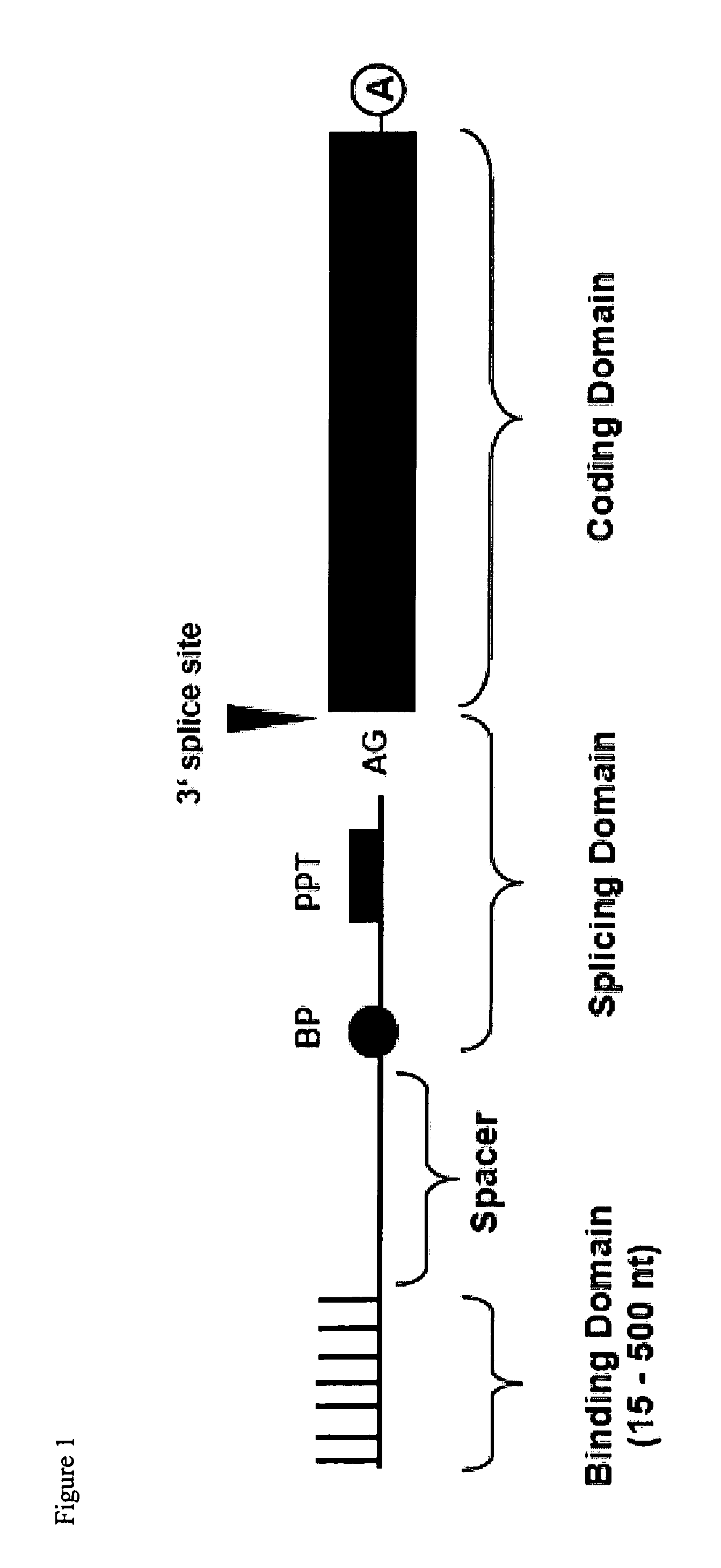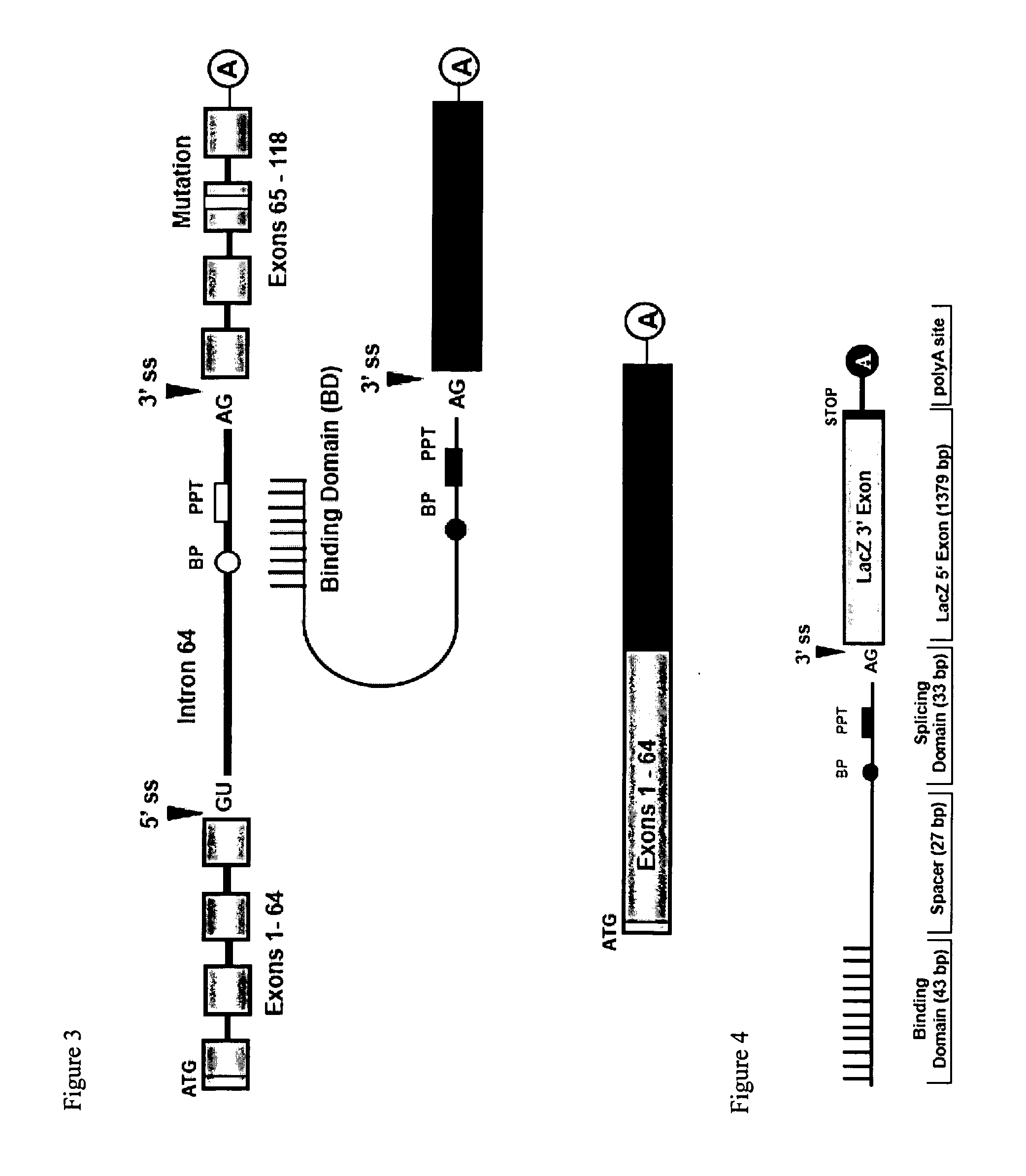Pre-MRNA trans-splicing molecule (RTM) molecules and their uses
a technology of transgenes and molecules, applied in the field of premrna transsplicing molecules (rtm) molecules and their, can solve the problems of limited transgene size, low gene transfer efficiency, and inability to deliver genomic size loci
- Summary
- Abstract
- Description
- Claims
- Application Information
AI Technical Summary
Benefits of technology
Problems solved by technology
Method used
Image
Examples
example 1
Trans-Splicing in a LacZ Model System
[0146]The feasibility of 3′ trans-splicing in correcting the COL7A1 gene has been established using a LacZ trans-splicing model repair system. In this system the inventors used intron 43 of COL7A1 as the Target for trans-splicing. The intron is flanked by the 5′ exon of the LacZ gene and the 3′ exon which contains two in-frame stop codons. Because of the stop codons, cis-splicing of the Target leads to a defective RNA transcript and therefore doesn't produce functional β-galactosidase. The second construct of the LacZ model repair-system is the RTM, consisting of a 43 bp antisense binding domain for intron 43 and the 3′ LacZ exon without the stop codons. Precise trans-splicing between Target and RTM in double-transfected cells replaces the mutant 3′ exon of the Target and therefore restores β-gal activity.
Analysis of Protein Function Restoration
[0147]The inventors transiently co-transfected 293FT cells with Target and RTM plasmid for investigatio...
example 2
Trans-Splicing in a Fluorescent Model System
[0148]The ability of RTM-induced trans-splicing to repair the COL7A1 pre-mRNA was further examined in a fluorescent-based transient co-transfection assay. In this trans-splicing model, a green fluorescence protein (GFP) is expressed in case of accurate trans-splicing. For this system, the inventors constructed a Target vector comprising the 5′ half of a GFP exon, intron 64 of COL7A1, and COL7A1 exon 65. The RTM consists of a binding domain (randomly designed, see below), complementary to a sequence of COL7A1 intron 64, the 3′ splicing domain including branch point (BP) and polypyrimidine tract (PPT), followed by the 3′ half of GFP. Downstream of the hemi-GFP exon the inventors inserted an internal ribosomal entry site (IRES) and a full-length DsRed gene, which acts as a control reporter in transfected cells. Precise trans-splicing between Target and RTM in co-transfected cells leads to an entire and functional GFP exon, which can be examin...
example 3
Efficient Trans-Splicing into Exon 9 of PLEC1 and Exon 52 of COL17A1, Compared to Intronic / Exonic Splicing Efficiency
[0161]A fluorescent reporter system was used to identify most functional RTMs specific for exon / intron 9 of PLEC1 and exon / intron 52 of COL17A1, wherein a screening system was established that is built up by an intron specific target molecule and a PTM library. The RTM contains a variable binding domain that base pairs with the target intron or upstream exon thereby inducing the recombination of both pre-mRNAs by trans-splicing (see FIG. 9).
[0162]The evaluation of trans-splicing efficiency took place using FACS analysis and real time PCR. At least two days after introduction of screening molecules into HEK293 cells, fluorescence microscopy and “Fluorescence Activated Cell Sorting” (FACS) analysis revealed the functionality of the RTMs according to their binding properties to the target intron. The expression of GFP should represent the total amount of specific trans-s...
PUM
| Property | Measurement | Unit |
|---|---|---|
| real time PCR | aaaaa | aaaaa |
| real time PCRs | aaaaa | aaaaa |
| RNA stability | aaaaa | aaaaa |
Abstract
Description
Claims
Application Information
 Login to View More
Login to View More - R&D
- Intellectual Property
- Life Sciences
- Materials
- Tech Scout
- Unparalleled Data Quality
- Higher Quality Content
- 60% Fewer Hallucinations
Browse by: Latest US Patents, China's latest patents, Technical Efficacy Thesaurus, Application Domain, Technology Topic, Popular Technical Reports.
© 2025 PatSnap. All rights reserved.Legal|Privacy policy|Modern Slavery Act Transparency Statement|Sitemap|About US| Contact US: help@patsnap.com



